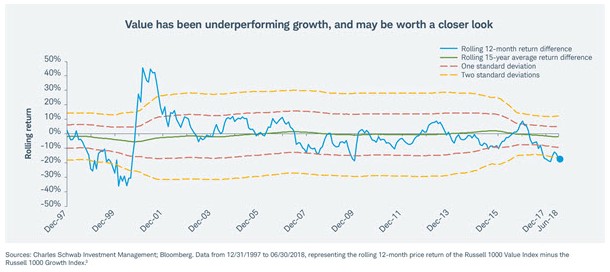Growth and Value Stocks: What Are They?
September 27, 2018
To Inform:
In our industry, we tend to throw around the terms “growth” and “value” when trying to describe stocks and investment styles. When you hear us use phrases like “this is a growth stock” or “this mutual fund manager invests in value stocks,” what do we actually mean?
Growth companies tend to be those whose sales and earnings are expected to grow at a faster rate than their competitors. Companies that match these characteristics might be a start-up company, such as a cutting-edge software company, or even an existing company in the process of reinventing themselves. For the later, imagine a company that once started as an online book retailer becoming one of the largest online merchants in the world! Wouldn’t that be something?
Whether it’s a startup or a more established company, growth companies are constantly developing new products and services as a way to remain competitive. As a result, they tend to not to pay dividends, opting to reinvest their profits back into their business.
Value companies tend to be those whose sales and earnings are expected to be growing at a slower rate than their competitors. These companies are typically more mature, offer more established products, and have more predictable businesses. A value company could include a large multi-national consumer staples company that retails products such as laundry detergent and toothpaste – not exactly a business you would expect to grow at a rapid pace!
The goal for many value companies is to have a more repeatable business model, focusing on what they do best. These companies don’t tend to need to heavily reinvest back into their businesses, opting to pay out a substantial portion of their profits in the form of cash dividends to their investors.
What’s the takeaway from of all of this? Should you invest in value stocks or growth stocks? As an investment professional, we can’t help but use the ultimate answer of “it depends!” Jokes aside, both growth and value stocks have historically gone through extended periods of leadership and underperformance, but both have merits in a diversified portfolio.
Most recently, growth stocks have outperformed value, but history shows this relationship goes in cycles, as seen below. When the blue line is above 0%, value has outperformed and vice versa:
 Source: Schwab Investment Management
Source: Schwab Investment Management
You can also see growth’s outperformance of value has started to reach historical extremes of which have not been seen since the late 1990’s! Could we begin to see the market begin to favor value stocks?
In our objective-based allocation strategies, we believe owning growth or value stocks should really depend on their objective. In a strategy like Provision, where a client’s objective relies on providing cash flow to fund current needs, our equity allocation will have more of a dividend focus, which lends itself to value. Clients will be hard-pressed to find high flying growth stocks in this strategy, it just doesn’t fit the objective. In Harvest, where the objective is risk-managed growth towards a long-term tangible goal, we will have a mix of value and growth stocks. We know that over short time periods, growth or value may be in favor, but owning both should help smooth out the ride longer-term.